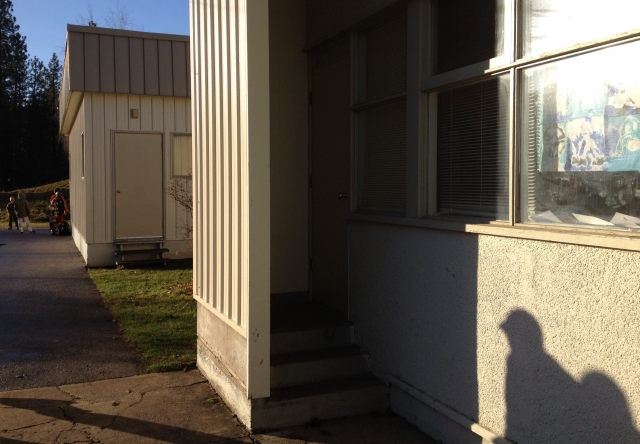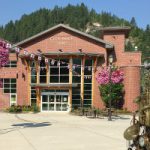Lockdown drills apart of the modern school experience
During a normal school day at Christina Lake Elementary, the quiet chatter of children reciting their multiplication tables, working on group projects and reading out loud filters out of the classrooms and into the halls.
Then a secret signal sounds. Not the usual fierce fire alarm, but something new. And within seconds the school falls silent, the doors are locked and the lights are turned off.
The children hide in a predetermined spot in their classrooms, barely breathing as the principal walks down the hall and shakes the door knob on every door to see if it’s locked. When the door knob to the Kindergarten Grade 1 classroom is rattled the 21 students, their teacher and the two parents present collectively suck in their breath.
Thankfully, this is only a drill and within five minutes, the principal, Bob Chapman, opens the doors to the classrooms and congratulates the children for a job well done.
Complete and utter lockdown was achieved in less than 10 seconds of the alarms sounding — an amazing feat in a school of 101 busy Kindergarten to Grade 7 students.
Like many school districts across the province, Boundary School District 51 has added a line of defense in their repertoire of annual school day drills since the quieter days of the 80s and 90s. Lockdown has now been added to the usual six fire drills and one earthquake drill held every school year. A necessary modern day phenomenon in light of school shootings (yes, even in Canada) and custody battles (a more likely scenario in our district).
Angela James, a parent of two boys, attended the Christina Lake Elementary lockdown drill held last month because her son was a bit frightened by the experience last year.
“It’s as safe as it can be,” she said of her confidence in the effectiveness of such a drill. “It depends on the situation – someone coming in with a gun might be different. That won’t likely happen here, but it is better to be prepared.”
School District 51 schools have had some lockdown procedures for more than 20 years, said superintendent Michael Strukoff. But, the procedures have evolved over the years as provincial, national and international events have happened.
Marci Butler, vice principal at Grand Forks Secondary School (GFSS), has been involved with the lockdown procedure for many years. Four years ago the policy underwent “tightening up” and is now reviewed annually. She said since it was adjusted a few years ago, the process is not so frightening to go through.
“It can be an emotional experience for people to go through, so we’re trying to make it as clear and precise as possible,” said Butler.
Over the years, several district schools have had to use lockdown for real. Butler said the process was really effective in those situations.
“The idea behind lockdown is to get people to be quiet and contained as quickly as possible – in less than 10 seconds the school should be locked and the people quiet,” said Butler. “If you can do that in a building like ours (GFSS), that is pretty amazing.”
She said practicing is important because the “unknown terrifies people”.
Grand Forks RCMP an important part of the lockdown plan
Last year the Grand Forks RCMP got involved with the annual review, contributing a fresh perspective and standardization into the plan. Once a school is in lockdown, the police take over the situation, so it was important to include them in the review.
Grand Forks RCMP Constable Renee Thomson is a parent of two children who go to school in Grand Forks. Before moving to Grand Forks in 2011, she was also involved, as a parent, in developing a lockdown procedure for her children’s Ontario school.
“We’d hate to show up and there was no plan in place,” said Thomson, from a police perspective. “It’s all about knowing what is going on before we get there …then we can concentrate on other things because we already have the background. We don’t have to worry about things like where do we meet, which doors are locked and which ones aren’t … It’s a partnership between us and the school.”
After reviewing the lockdown plans for each school in the district, Thomson helped in standardizing the plan between schools so that police will know exactly what’s going on should they be called in to help.
Thomson said School District 51 has a great plan in place and she feels the mandate by the board to have every school practice the lockdown procedure at least twice a year is “really great”.
Lockdown is not meant to be frightening
Locking down the school isn’t always done because there’s something scary happening. It could be because there’s a loose dog on the property or a situation happening down the road like a gas leak.
“It will likely be used for something less dramatic,” said Thomson. “Lockdown is not always done because there’s something at the school. It could be across the street or around the block. It’s all about keeping the kids safe and accounted for.”
“It’s not scary but it is important to have the lockdown drill so the kids won’t be scared when it does happen,” said James, after experiencing the drill herself.
Thomson said parents need to talk to their kids about lockdown with an emphasis on safety, rather than focusing on a scenario that might scare them.
“Certain kids can handle the truth while others can’t,” said Thomson. “It’s definitely something parents should be speaking to their kids about. It’s not something you want to instill fear in them about, but that they need to obey what the teacher says.”
“I think it is important to talk to the kids about (the lockdown drill) before and why,” agrees James. “The teachers do a good job, but it needs to be targeted at the kids not getting talked to at home. It can happen anywhere. I always go on the cautious side and talk about stranger danger but I don’t want to scare the heck out of them.”
Danger from within
Statistically, most incidents that would create a lockdown situation come from someone within the school population, said Butler.
“That is a bigger issue,” she said. “Our community is no different than any other community and we have our challenges too. It is unrealistic to say things wouldn’t happen here.”
She said mental health issues are often at the heart of an incident. At our schools, the district tries to identify and provide help to those individuals before a problem ever arose.
“There are never perfect solutions and there is never enough money but I think the big thing is in recognizing mental health issues and addressing them,” said Butler.


























Comments